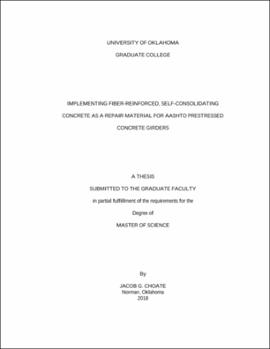| dc.description.abstract | In 2017, the American Society of Civil Engineers released a report card stating that, of the 614,387 bridges in the United States, nearly 40% are past their design life. Within a few months of the report, the U.S. Department of Transportation posted that over 16% of the nation’s bridges are in “poor” or “structurally deficient” condition. With the growing awareness for the current condition of the United States’ infrastructure, the FHWA has allocated tens of billions of dollars towards the repair and improvement of bridge and highway infrastructure every year and yet, the current, subpar status is retained. Concrete structures account for almost half of the nation’s bridges and to fix an extensively damaged concrete bridge girder, it is common practice to replace the entire member or perform multipart repairs. Either of these options are very costly and can take several months to complete.
This study serves as a continuation of two other research projects; one of which tested an AASHTO bridge girder, the other featured the development of fiber-reinforced, self-consolidating concrete (FR-SCC) as a repair material. The AASHTO, prestressed concrete girder used in the previous study is the subject of repair and repair testing for this research. The girder had been donated by the Oklahoma Department of Transportation after being retired from service and brought into the lab to be tested until failure to acquire its capacities. The state of the girder was documented photographically and through computer-aided design software. Upon completion of the surveying, the girder was repaired using the previously developed FR-SCC as a replacing, repair material. This repair method requires all damaged concrete to be removed from the girder and any internal reinforcing to be repaired or replaced, as needed. Since the girder is prestressed, the original stress transferred from the strands was reapplied by existing tensioning methods, such as internal splicing. The repair material was cast such that the original shape of the girder was retained, thus maintaining the same aesthetics and geometric properties. Once the concrete had cured and the strand stress reapplied, the girder was tested again to obtain comparable results to the original testing. By analyzing the data from the initial testing and the repair testing, a practical conclusion for the plausibility of FR-SCC implementation as a repair technique was ascertained.
The aim of this study was to repair the girder with FR-SCC and develop a comparison of its capacities before and after repair. The repair material used for each repair yielded a comparable compressive strength to that of the existing concrete in both the girder and the composite deck, while also retaining the necessary workability properties to fully fill the repair zones. When testing the repaired girder, the failure mechanisms from the initial, pre-repaired testing were mitigated and the repair sections acted cohesively with the existing girder portions. Despite the limited extent of the repair zones, the girder was able to sustain over three-quarters of the maximum load from its initial testing. The FR-SCC displayed comparable fresh and mechanical properties to that of existing self-consolidating concretes used for prestressed concrete members. | en_US |
